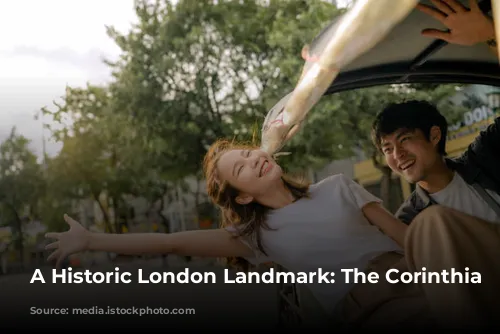The Corinthia Hotel London stands tall at the intersection of Northumberland Avenue and Whitehall Place, a prime location in the heart of London. This impressive building boasts a rich history, having served as both a luxurious hotel and a crucial government building throughout the years.
From Grand Hotel to Government Hub
Originally opening its doors in 1885 as the Metropole Hotel, this grand establishment quickly became a favorite among London’s elite. Its close proximity to the Palace of Westminster and government offices in Whitehall made it a popular choice for dignitaries and socialites. However, the hotel’s location also drew it into the heart of historical events.
During both World Wars, the Metropole was requisitioned by the British government to accommodate essential staff and operations. This strategic location provided a crucial base for military commanders and intelligence agencies. After World War II, the hotel was purchased by the Ministry of Defence and transformed into a government office complex.
Reimagined as a Hotel and Residential Complex
Fast forward to 2007, the Crown Estate sold the building, and it underwent a complete restoration and rebranding as the Corinthia Hotel. The hotel’s rebirth as a luxury destination further cemented its position as a prominent London landmark.

A Glimpse into the Past: Notable Events and Residents
The Metropole Hotel’s history is interwoven with numerous notable events and prominent figures. For instance, the Prince of Wales, later King Edward VII, enjoyed the hotel’s hospitality, reserving a private box in the grand ballroom and occupying the Royal Suite.
In the 1920s, the hotel’s Midnight Follies cabaret gained immense popularity. Bert Firman, a young violinist, rose to become the youngest bandleader in the world while performing with the Midnight Follies Orchestra. The hotel’s vibrant atmosphere attracted a diverse clientele, including renowned musicians like Mantovani and legendary rugby players, who celebrated the England team’s historic victory over the New Zealand All Blacks in 1936.

A Key Role in Wartime Operations
The hotel’s strategic location continued to play a vital role during the Second World War. It served as a crucial base for various government departments, including the Air Ministry and the Ministry of Defence. Interestingly, Room 424 housed the first headquarters of MI9, a renowned British intelligence agency.

A Transformation and a Return to Its Roots
After the war, the hotel continued to serve as a government complex for several decades. However, a new era began in 2007 when the building was acquired by a consortium and re-developed into a hotel and residential complex. The hotel’s rebirth as a luxury destination brought back its former grandeur, while preserving its historic legacy.

A Modern Landmark: A Stage for Modern Times
The Corinthia Hotel has once again become a vibrant hub of activity, attracting celebrities and filmmakers alike. The hotel was the venue for the official announcement of the James Bond film Skyfall and served as a filming location for the thriller Red Sparrow, further solidifying its place in popular culture.
The hotel’s commitment to art and culture is showcased through its Artist in Residence program, which provides a platform for emerging artists to showcase their talent. This ongoing program continues to add to the hotel’s cultural significance, reflecting its evolution from a historic landmark to a contemporary center for art and creativity.
The Corinthia Hotel’s story is one of transformation and resilience. From its beginnings as a luxurious hotel to its role in the heart of government operations, the building has witnessed centuries of history. Today, it stands as a testament to the enduring power of a landmark that seamlessly blends its past with the vibrancy of the present.








